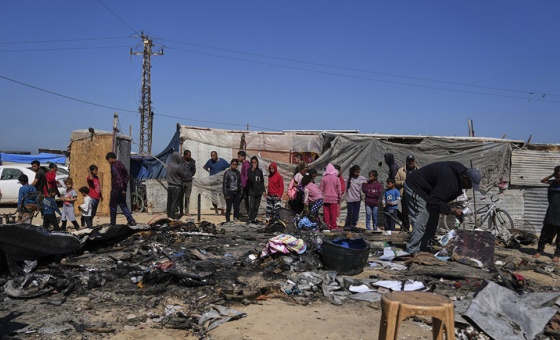This is the last article you can read this month
You can read more article this month
You can read more articles this month
Sorry your limit is up for this month
Reset on:
Please help support the Morning Star by subscribing here
Everyone has a cultural comfort zone — a space they can effortlessly inhabit without feeling challenged.
For me, it’d probably be sat watching some terrible indie band with girl/boy vocals and heartwarming harmonies, playing third on the bill at a 100-capacity venue, maybe with a pint of cider in my hand.
Instead, I find myself sat in the George Bernard Shaw Theatre at the Royal Academy of Dramatic Art, about to watch an opera about human cloning.
The performance is part of the Tete a Tete Opera Festival, drawing to a close this week at King’s Place in London’s King’s Cross.
Mannequin is billed as the first video opera about cloning. It’s certainly the first I’ve seen. We sit down and face a huge image of the performer, Heloise Werner, projected on the bare brick wall behind the performance space.
This image is joined by the physical reality of the performer herself, standing in front. She is singing of her life as Ania, a clone of a famous singer, Anna, who died young at 27.
Set in a near future even more obsessed with celebrity than the present day, she was raised to be Anna. The pianist and conductor, William Cole, signals to the visual team and fellow musicians, and we’re ready to begin. Animated strands of DNA float across the background as the story unfolds.
“Who needs new songs?” sings Werner as Ania, justifying her existence. “Everything’s been done before. All the songs are already written.”
She suffers a crisis of confidence when her career as an imperfect copy of a famous star falters, and following a chance meeting with another clone of Anna.
The opera, sung in English, is sometimes hard to follow, in part because the flurry of animated visuals are so stunning, you can sometimes lose the thread of the music and the singer’s performance.
Things come to a head when Ania meets her fellow clone: a supermarket worker, but a more perfect copy of the dead singer than Ania could ever hope to be.
Werner interacts with her own animated twin, singing in wonderment as her clone nods and shrugs along.
“My interest was in the moral implications of things such as human cloning and designer babies,” says composer Maria Vatenina, “though from a more psychological perspective. What kind of person would a cloned human be? What mental health risks would they have to overcome?”
Vatenina, who put the project together alongside animation artist Izabela Barszcz, cites Persona by Ingmar Bergman and Tarkovsky’s Solaris among the inspiration for the work. I felt it also raised similar philosophical questions as the Japanese anime Ghost in the Shell.
I asked about the difficulties synchronising the striking visual work with the unfolding opera.
“I actually had no frustrations working this way as I almost never had to compromise my music style to fit the visuals,” said Vatenina.
“The only real difficulty was [Barszcz] needed my music as soon as possible so she could start working on the visual, and I needed more time to write it. But she was very patient with me.”
A week after the performance, certain images and concepts from the evening are still with me, at the back of my mind: flickering, like the image on the screen, and troubling me on a level I can’t fully explain. In short: it’s done what art is supposed to do.
“Our first reaction to artistic work is usually on a rather emotional and aesthetic level,” says Vatenina. “It makes you feel something or it doesn’t. You either like it or you don’t. Then you begin to think about what it all meant. Sometimes there is no meaning and then you project your own meaning onto it. I like to leave space for interpretation.
“And we still don’t know what happened to Alice.”





